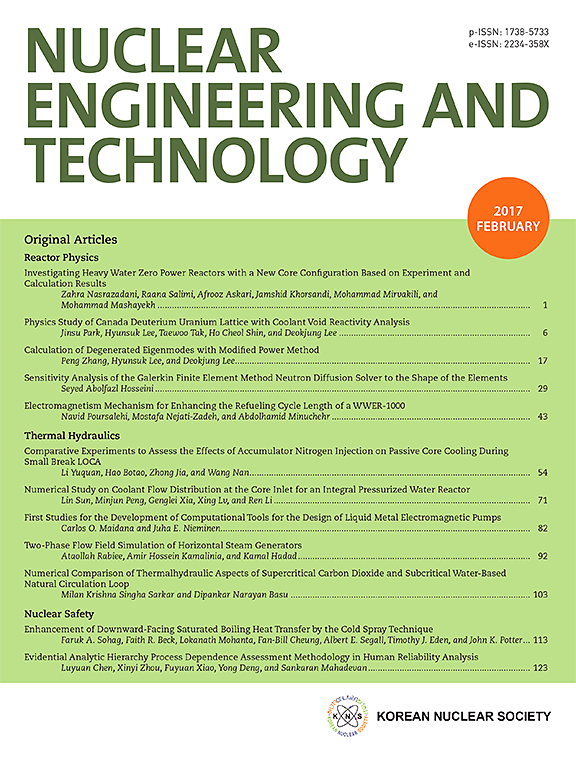Study of fluidelastic instability in the streamwise and transverse directions through tube array under two-phase flow conditions using pressure effects
IF 2.6
3区 工程技术
Q1 NUCLEAR SCIENCE & TECHNOLOGY
引用次数: 0
Abstract
The fluidelastic instability (FEI) in heat exchanger tubes has been of widespread concern due to its tendency to cause damage to the tubes. Generally, FEI in the transverse direction of the tube occurs earlier than in the streamwise direction, and the intrinsic frequency of the tube as well as the way of tube distribution have a great influence. The mechanisms involved in inducing FEI need to be further investigated. We set up an air-water two-phase flow water tunnel test system and adopt a normal triangular arrangement plate with a pitch-to-diameter ratio of 1.41 to conduct experiments. It was ensured that FEI could occur in the experimental flow range, by varying the intrinsic frequency of the flexible tube. The fluidelastic instability phenomenon was investigated in a single flexible tube array and a cluster of seven flexible tubes (the central cluster). Comparative analysis was conducted between the results of the two array configurations. The experiments involved concurrent streamwise and transverse directions, and an analysis of the pressure exerted on the flexible tubes. Additionally, the “transitional” state observed in flexible tubes under strongly coupled vibration in the central cluster was explored. The findings indicated that a cluster of seven flexible tubes intensified the vibration coupling between bundles, leading to a more complex flow field around the tube bundle perimeter, consequently exacerbating tube vibration. Furthermore, under the “transitional” state, enhanced stability was manifested. Additionally, instability in the streamwise direction was primarily controlled by the stiffness mechanism; a single flexible tube did not exhibit fluidelastic instability in the streamwise direction, while the central cluster did. This paper recommends an instability constant (K) value of 3.4 for the Connors formula for a normal triangular tube bundle configuration with the pitch-to-diameter ratio of 1.41, thereby providing empirical and theoretical support for the vibration analysis of tube bundles.
利用压力效应研究两相流条件下通过管阵列的流弹性流向和横向不稳定性
换热管中的流弹性不稳定性(FEI)因其容易造成换热管损坏而受到广泛关注。一般来说,换热管横向的流弹性不稳定比流向的流弹性不稳定发生得早,换热管的固有频率和换热管的分布方式对其有很大影响。诱导 FEI 的相关机制有待进一步研究。我们建立了气水两相流水洞试验系统,采用间距直径比为 1.41 的正三角形布置板进行实验。通过改变柔性管的固有频率,确保 FEI 在实验流量范围内发生。在单根柔性管阵列和由七根柔性管组成的管群(中心管群)中研究了流弹性不稳定现象。对两种阵列配置的结果进行了比较分析。实验包括同时进行的流向和横向实验,以及对软管所受压力的分析。此外,还探讨了在中心集群的强耦合振动下软管观察到的 "过渡 "状态。研究结果表明,由七根柔性管子组成的管束群加强了管束之间的振动耦合,导致管束周边的流场更加复杂,从而加剧了管子的振动。此外,在 "过渡 "状态下,稳定性增强。此外,流向方向上的不稳定性主要由刚度机制控制;单根柔性管在流向方向上没有表现出流体弹性不稳定性,而中心管束则表现出不稳定性。本文建议,对于间距与直径比为 1.41 的正三角形管束配置,康纳斯公式的不稳定性常数 (K) 值为 3.4,从而为管束振动分析提供经验和理论支持。
本文章由计算机程序翻译,如有差异,请以英文原文为准。
求助全文
约1分钟内获得全文
求助全文
来源期刊

Nuclear Engineering and Technology
工程技术-核科学技术
CiteScore
4.80
自引率
7.40%
发文量
431
审稿时长
3.5 months
期刊介绍:
Nuclear Engineering and Technology (NET), an international journal of the Korean Nuclear Society (KNS), publishes peer-reviewed papers on original research, ideas and developments in all areas of the field of nuclear science and technology. NET bimonthly publishes original articles, reviews, and technical notes. The journal is listed in the Science Citation Index Expanded (SCIE) of Thomson Reuters.
NET covers all fields for peaceful utilization of nuclear energy and radiation as follows:
1) Reactor Physics
2) Thermal Hydraulics
3) Nuclear Safety
4) Nuclear I&C
5) Nuclear Physics, Fusion, and Laser Technology
6) Nuclear Fuel Cycle and Radioactive Waste Management
7) Nuclear Fuel and Reactor Materials
8) Radiation Application
9) Radiation Protection
10) Nuclear Structural Analysis and Plant Management & Maintenance
11) Nuclear Policy, Economics, and Human Resource Development
 求助内容:
求助内容: 应助结果提醒方式:
应助结果提醒方式:


